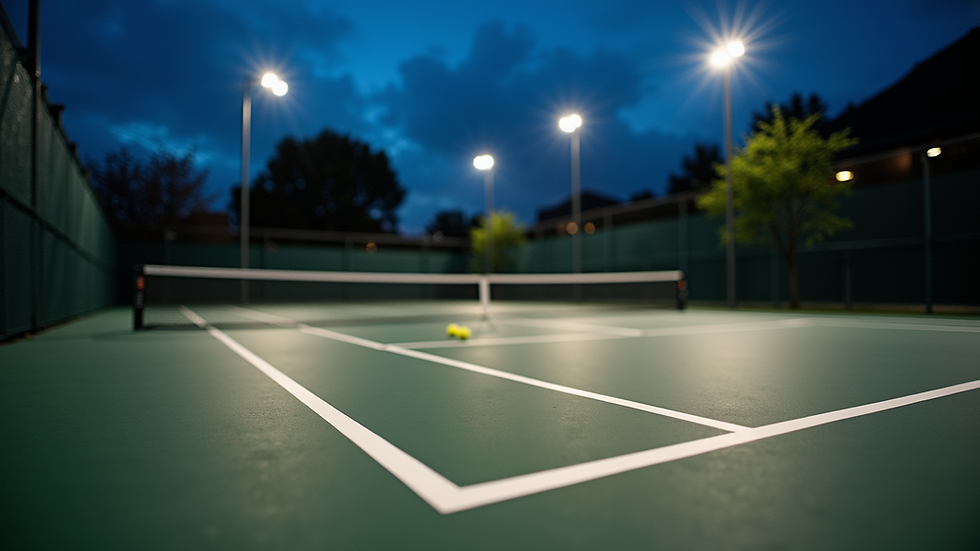The Essential Guide to Optimal Pickleball Court Size and Innovative Design Strategies
- louai86alsam
- Aug 20
- 3 min read
Pickleball is more than just a sport; it’s a growing community that brings together players of all ages. With its rapid rise in popularity, understanding the optimal court size and innovative design strategies is essential for creating a fun and engaging playing experience. This guide covers the specifics of pickleball court dimensions, key layout considerations, and design elements that maximize both functionality and appeal.
Understanding Pickleball Court Size
Knowing the standard dimensions of a pickleball court is critical for fair play. A regulation court measures 20 feet wide by 44 feet long for both singles and doubles matches. For perspective, this size is very similar to that of a badminton court, making it easier to convert existing sports facilities for pickleball use.
Court Markings
Clear court markings are vital for gameplay. Each court is divided into two equal halves by a centerline, with each half further divided into service areas. The non-volley zone, referred to as the "kitchen," extends 7 feet from the net on both sides. This area is crucial as players are prohibited from volleying the ball while standing in it, which helps maintain the integrity of the game.

Space Requirements
In addition to the court dimensions, adequate surrounding space is important. A minimum of 10 feet of clearance on all sides is recommended. This ensures players have enough room to move freely and reduces the risk of injury. This space is also beneficial for accommodating spectators, enhancing their viewing experience significantly.
Innovative Design Strategies
Designing an optimal pickleball court involves more than just following standard dimensions. Implementing innovative strategies can dramatically enhance the overall experience for both players and spectators.
Surface Material
The choice of surface material significantly impacts play quality. Common options include asphalt, concrete, and specialized sports surfaces. Asphalt, for example, is durable and cost-effective, while specialized surfaces, like cushioned acrylic, provide excellent grip and bounce. Research shows that players prefer courts with textured surfaces that promote consistent ball movement, making the game more enjoyable.
Lighting Considerations
For extended playtime during evenings or in low-light conditions, proper lighting is essential. LED lights have emerged as a popular choice for courts due to their energy efficiency and ability to provide bright, uniform illumination. Studies indicate that well-lit courts can improve player performance by 30% as they reduce shadows and enhance visibility.

Fencing and Safety Features
Safety is paramount in court design. Installing sturdy fencing around the court protects players from stray balls and keeps spectators safe. Adding padding to the fencing can further reduce the risk of injury from accidental collisions, making a significant difference during high-energy matches.
Accessibility and Inclusivity
As pickleball continues to grow, ensuring accessibility and inclusivity in court design is crucial. Making courts wheelchair-accessible and providing appropriate seating for spectators with varying mobility needs fosters a welcoming environment for all players. According to a study, inclusive design can increase participation levels by up to 25% in community sports.
Community Engagement
Engaging the community in the design process can lead to a more successful and frequently used facility. Holding meetings or surveys allows local players to share their needs and preferences, which helps ensure the court meets community expectations and serves its users effectively.
Maintenance and Longevity
To maintain optimal conditions, regular maintenance is essential. This includes cleaning the surface, repairing any cracks, and ensuring that court markings are always clear. A proactive maintenance schedule can prolong the life of the court and greatly improve the quality of play for everyone.
Seasonal Considerations
Depending on local climate conditions, seasonal factors can influence court usage. For example, in areas with harsh winters, investing in court covers or heating systems may be advisable for year-round play. On the other hand, in warmer climates, providing shade structures can improve comfort for both players and spectators, enhancing their overall experience.
Creating a Welcoming Environment for Everyone
Designing an optimal pickleball court requires careful consideration of its size, layout, and innovative features that enhance the playing experience. By adhering to standard dimensions, implementing thoughtful design strategies, and prioritizing accessibility, communities can create inviting spaces for players of all ages and skill levels. As the love for pickleball continues to spread, investing in quality court design will ensure this exciting sport remains accessible and enjoyable for everyone.





Comments